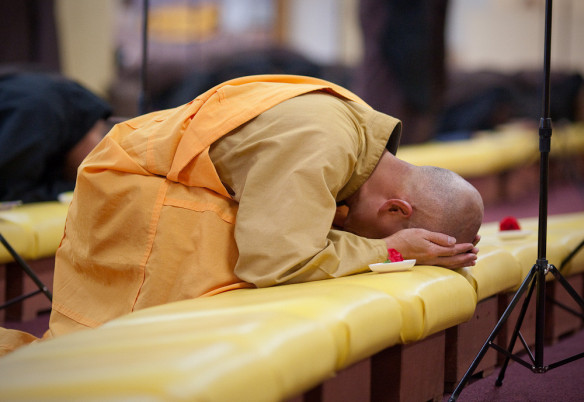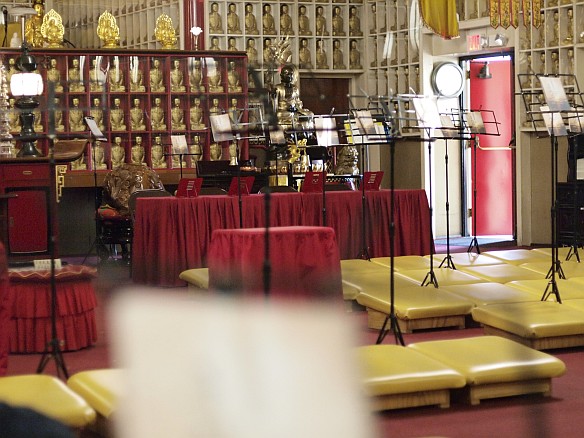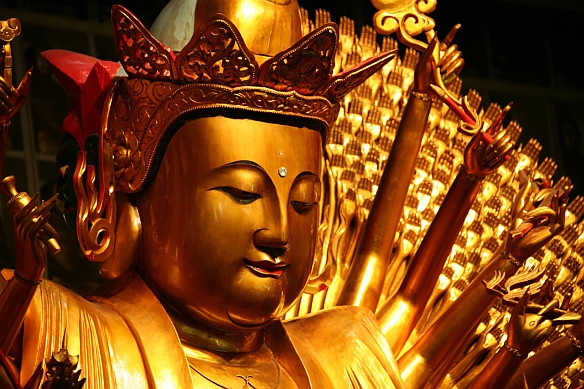
So what’s going on?
Being moved all the time by sensual overload and emotional upheavals. Hoping to stay amused and diverted enough to avoid being left alone with ourselves. Maybe that’s our greatest fear—to be at home with ourselves and not connected. The curse of the contemporary age: existing virtually, connected to everywhere and everybody all the time, but not sensing and feeling the who. How do we get back to the who? The who that is comfortable with itself in time and space. The who that isn’t lost, befuddled and overwhelmed by experience. The who that is aware of experience. To feel it purely in its emptiness/fullness—not moving in or out of “e-motion”—requires fearless patience and profound hope, both of which are in short supply at the moment.
Was it misplaced emotional entitlement? Was it a promise of happiness on the cheap?
We have transitioned from a sense of innocent hope and desire into an almost desperate fear, driving us on an endless quest for new, exciting experiences to assure our existence. We’ve tried almost every possible experience many times. At 30 maybe a baby is the answer. That will certainly take up 20 years, more or less. How could so much time, creativity and freedom come to this? Was it misplaced emotional entitlement? Was it a promise of happiness on the cheap? Does endless experimentation with new identities and relationships lose its ability to inspire? It is a time of lots of questions and few solid answers. Read More …

On April 11 – 15, Bhikshuni Heng Yun lectures on the life and teachings of the Venerable Hsu Yun, also known as Empty Cloud. [Learn more]
 [Admin’s note: This spring, volunteers and staff participated in a 7-day Guan Yin Practice Retreat. During the Guan Yin session, participants recite the name of Guan Yin Bodhisattva. In our Chan tradition, meditation brings the mind back to whatever method of practice we are doing, whether it’s mental awareness, reciting, bowing, etc… Inevitably, the mind wanders off, and we gently bring it back. Once familiar with the motion of wandering off, we see what compels the mind to stray and develop a resistance against the habituation of that e/motion.]
[Admin’s note: This spring, volunteers and staff participated in a 7-day Guan Yin Practice Retreat. During the Guan Yin session, participants recite the name of Guan Yin Bodhisattva. In our Chan tradition, meditation brings the mind back to whatever method of practice we are doing, whether it’s mental awareness, reciting, bowing, etc… Inevitably, the mind wanders off, and we gently bring it back. Once familiar with the motion of wandering off, we see what compels the mind to stray and develop a resistance against the habituation of that e/motion.]
“I will abide pervading one quarter with a mind
imbued with loving-kindness; likewise the second,
likewise the third, likewise the fourth; so above and
below, around and everywhere; and to all as to
myself. I will abide pervading the all-encompassing
world with a mind imbued with compassion;
abundant, exalted, immeasurable, without hostility,
and without ill will.”
– Suffusion of the Divine Abidings, Traditional Theravada Chant
“Fine and wondrous sound: Gwan Shr Yin!
Brahma-sound, steady as the tides.
A name transcending every worldly sound,
Gwan Yin! Stay forever in my mind.”
– Universal Door Chapter; Dharma Lotus Sutra
Many of the Buddha’s early teachings were framed as the negative of something else–anicca (impermanence) and anatta (not self) for example. Perhaps that’s not so surprising if one considers that the Buddha is trying to point to an experience that eludes languages and can only be stated as opposites of things we know. This pedagogical approach is possibly one of the reasons why some people think that Buddhist teachings are nihilistic and pessimistic. While demonstrating that Buddhist teachings are the opposite of nihilistic and pessimistic would be out of the scope of this brief post, I would like to allude to one example (among many) of the Buddha’s teachings, where he extolled his disciples to abide with their minds in the positive mental states of loving kindness, compassion, sympathetic joy, and equanimity. Read More …

One of my views in the Buddha Hall
[Admin’s note: This spring, volunteers and staff participated in a 7-day Guan Yin Practice Retreat. During the Guan Yin session, participants recite the name of Guan Yin Bodhisattva. In our Chan tradition, meditation brings the mind back to whatever method of practice we are doing, whether it’s mental awareness, reciting, bowing, etc… Inevitably, the mind wanders off, and we gently bring it back. Once familiar with the motion of wandering off, we see what compels the mind to stray and develop a resistance against the habituation of that e/motion.]
Day 1: Tired from the cold and rain; finishing up earlier work. Then went to session. Felt better after 1.5 hours. It’s not that I have less false thinking, but I can separate from my thoughts and hear them more clearly—even though I’m more tired.
Day 2:
[Notes from evening lectures with Doug Powers]
DP: Every time you have trouble with your body or mind, it’s an opportunity to work through your impediment. It’s very simple.
DP: Cultivation is developing the resistance against your habituation.
DP: In a Guan Yin Session, whatever is coming up is what you need to be dealing with.
DP: A better definition for faith is confidence; believe in what you are doing in your process.
Day 3: Had the recurring affliction again. In the afternoon, after getting lost or stuck in the same mood and thought patterns, I recall a number of things: Read More …

The History of Buddhism Lecture Series continues in April. Steven Tainer will discuss “Tibetan Buddhism” on April 6, and the Venerable Ajahn Pasanno will speak on “The History of the ‘Forest Tradition’ in Thailand” on April 27. [Learn more]
 [Admin’s note: This spring, volunteers and staff participated in a 7-day Guan Yin Practice Retreat. During the Guan Yin session, participants recite the name of Guan Yin Bodhisattva. In our Chan tradition, meditation brings the mind back to whatever method of practice we are doing, whether it’s mental awareness, reciting, bowing, etc… Inevitably, the mind wanders off, and we gently bring it back. Once familiar with the motion of wandering off, we see what compels the mind to stray and develop a resistance against the habituation of that e/motion.]
[Admin’s note: This spring, volunteers and staff participated in a 7-day Guan Yin Practice Retreat. During the Guan Yin session, participants recite the name of Guan Yin Bodhisattva. In our Chan tradition, meditation brings the mind back to whatever method of practice we are doing, whether it’s mental awareness, reciting, bowing, etc… Inevitably, the mind wanders off, and we gently bring it back. Once familiar with the motion of wandering off, we see what compels the mind to stray and develop a resistance against the habituation of that e/motion.]
If you encounter something troublesome, just recite “Namo Guanshiyin Bodhisattva” and the trouble will go away. Troubles fear Guanshiyin Bodhisattva, because he can contemplate them and find their cause; as soon as he discovers their cause, the troubles go away. This is a most wonderful method, the best way to solve problems.
– Venerable Master Hsuan Hua
I have a tendency to be a bit of a skeptic; among the many minds I can adopt, one of them is definitely the mind of a scientist. So there’s always been something about statements like the one above that is difficult for me to accept. The voice has a bit of magical realism to it. Is this something that I’m actually expected to put faith in, much less put into practice? I consider this perspective of mine to be cultural, to a large extent. After all, why would any critically-educated American mind, brought up in a world grounded in scientific progress in the face of superstitious and corrupt religious institutions, ever consider swallowing a statement like this whole? Read More …

The view from a morning walk at CTTB
A few weekends ago, I left the monastery for the first time. The shock wasn’t as great as I thought it would be. In fact, the differences I noticed were mostly in myself, and subtly in the environment around me.
Some distinctions were obvious. Like sound. Driving through the City of Ten Thousand Buddhas (CTTB) gate was like crossing a threshold into a world of noise. Coming from an environment grounded in simplicity and spiritual practice, the energy level was loud. Cars. Colors. Music. Words, whispers, shouts. Drinks clanked and food fanned out in every size, shape, and color. Fliers adorned telephone poles while billboards splashed attention away from the clouds.
It was like peeking through a window into a familiar dream. Friends clustered at café tables, sipping in the warmth of each other through trains of conversations about their week. Flustered parent-speeding-with-child around the grocery store. The city streets absorbing weekend traffic, while storefronts and torn candy wrappers glimmered in the sunlight. All the while, flowers bloomed in all directions—catching sight of the horizons of spring. Read More …

My stepfather passed away Sunday afternoon, having been bedridden with cancer for two months. There are a lot of stories to be told about what the past two months have been like for everyone involved, but for this post I just want to tell the story of what my own experience has been like, and how living at The City of Ten Thousand Buddhas (CTTB) has changed that for me.
More than any other Buddhist teacher I have encountered, Venerable Master Hsuan Hua emphasized the importance of filiality in Buddhist practice. I can’t say that I completely comprehend all of his reasons for this unusual emphasis, but I can say that my encounter with this teaching has had an immeasurably positive impact on my life in a very short period of time.
I could say that most of what I’ve learned about Master Hua’s teachings on filiality have come to me through one of this senior disciples, Rev. Heng Sure, through various lectures. Rev. Heng Sure describes filiality as “the practice of returning the kindness of one’s parents.” Read More …
 SHARE
SHARE EMAIL
EMAIL COMMENT0 comments
COMMENT0 comments 







